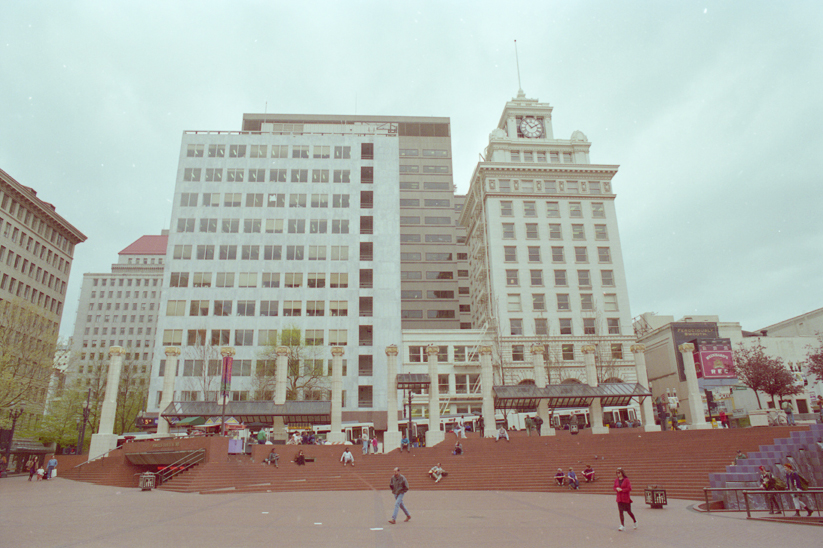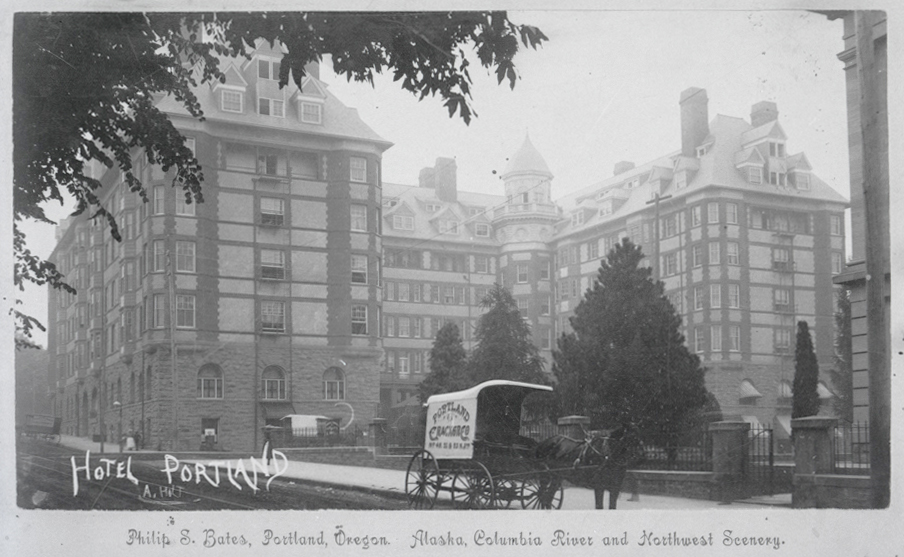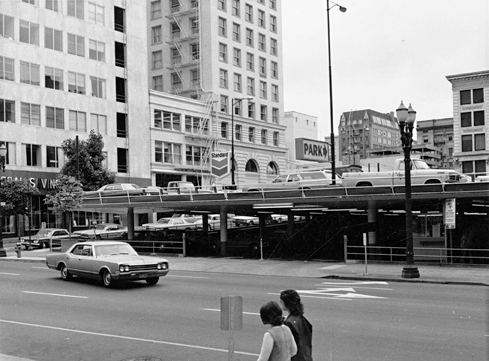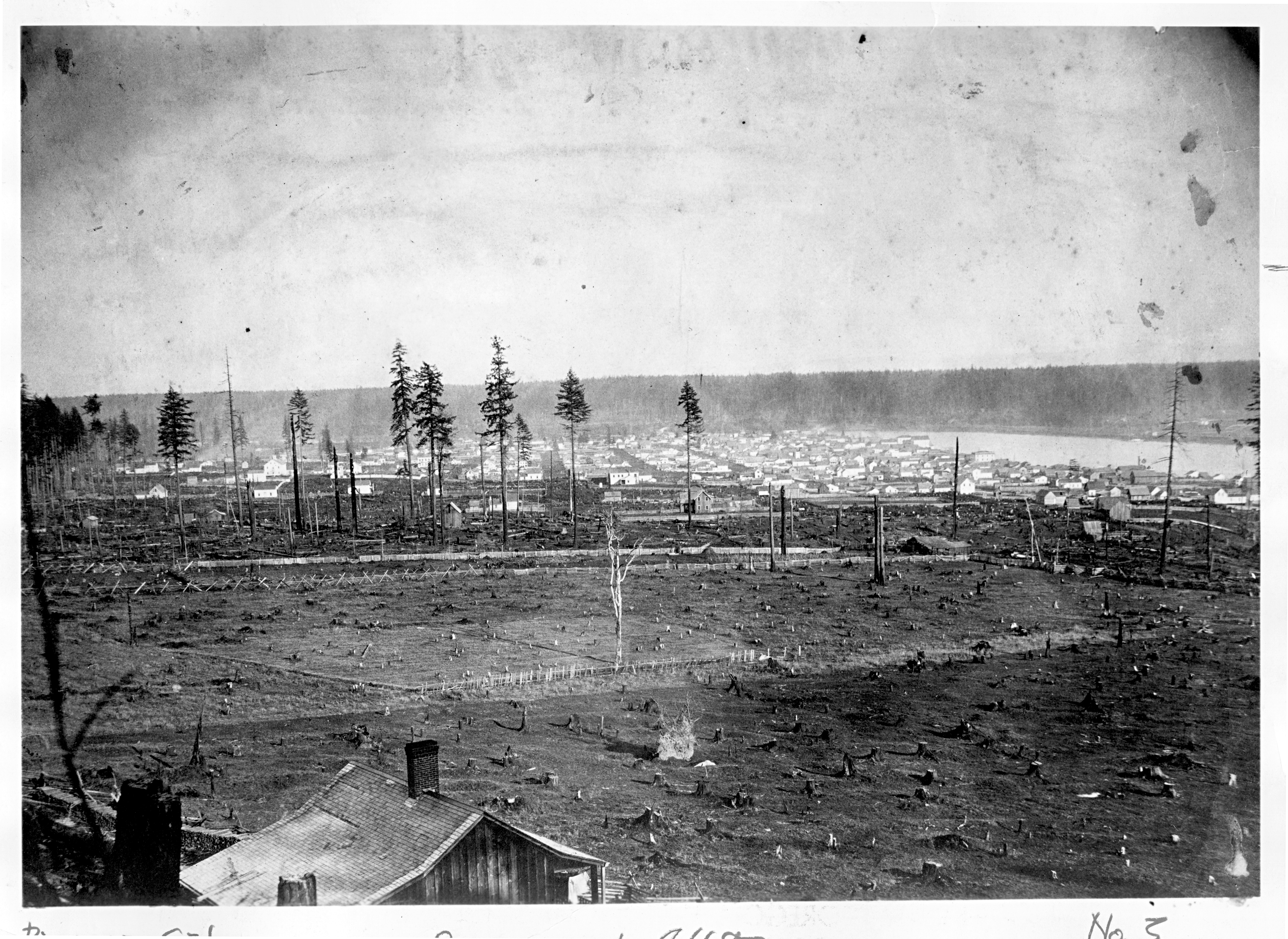In the heart of downtown Portland, Pioneer Courthouse Square fulfills its mission to “welcome all to our community gathering place.” Its popularity is evident in the 26,000 people who traverse the Square every day and the hundreds of events that take place there each year. Recognized by the American Planning Association as one of the premier public spaces in the United States, Pioneer Courthouse Square has, as the design team envisioned, become Portland’s “living room.”
Pioneer Courthouse Square was dedicated on April 6, 1984, but the block it occupies has a long history. Children who attended a school that opened there in 1858 were the first to regularly make their way to the area bounded by Southwest Yamhill and Morrison and Southwest Sixth and Broadway. In 1882, the block was sold to the Northern Pacific Terminal Company, but the hotel that the struggling railroad planned did not open until a group of Portland businessmen rescued the project. The Queen Anne-style Portland Hotel and its gated courtyard occupied the entire block from 1890 to 1951, when Meier & Frank purchased the property. Saddening many, the stately and well-loved hotel was torn down to make way for a parking lot.
In 1970, when Meier & Frank requested a permit to erect a twelve-story parking structure, the city council and the Portland Planning Commission balked, tabling the request so they could consider it in the context of a plan for reinvigorating the entire downtown. It took four years until the final decision was made to convert the block to public space. Portland architect Willard Martin led the winning design team of Doug Macy, Robert Reynolds, Lee Kelly, Spencer Gill, and Terence O’Donnell, beating 160 other submissions to the juried competition. In May 1980, the city council accepted their plan for a multi-use urban plaza.
As the city and the design team debated changes to the plan, the Friends of Pioneer Courthouse Square raised over $1.5 million to supplement other donation and grant funds, enabling Portland to receive matching federal dollars. While the Square's open-air design was criticized by many businesspeople, who worried it would attract transients or the homeless, it was that very feature that allowed the city to accept funds from the Bureau of Outdoor Recreation.
The Square’s paving stones are inscribed with the names of donors, and people still search the Square to locate “their” pavers. The result is a public space that one writer described as a “celebration of the urban spirit” of Portland.
While visitors may note individual elements of the Square, the design team was as concerned with “space as an object” as with “objects in space,” which is why the Square works so well for so many different uses. The main level of the Square is open space surrounded by an amphitheatre and a few multi-level structures that house a coffee shop, television station, and offices for both TriMet (the public transportation network for the metropolitan area) and the Portland Oregon Visitors Association. The Square’s various levels offer seating for special events, from sand castle contests and flower shows to political rallies and holiday celebrations.
The Square’s sometimes amusing and eccentric design elements invite curiosity while respecting both the site’s history and Portland’s character. The Weather Machine kinetic sculpture announces the weather each day at noon. Allow Me, a J. Seward Johnson statue of a man hurrying across the square holding an umbrella, mimics the city’s pedestrians. The wrought-iron gate that once adorned the Portland Hotel welcomes visitors. Rumor has it that the five gargoyle heads on the waterfall fountain represent the mayor and the four city commissioners. Portlanders and tourists alike can frequent the food carts, play chess at the painted or bronze chessboards that adorn sitting areas, or buy flowers while they wait for the light rail train. A true gathering place for the community, Pioneer Courthouse Square lives up to both the vision of its early proponents and its mission today.
-
![Pioneer Courthouse Square, April 1994.]()
Pioneer Courthouse Square, Apr 1994, bb008511.
Pioneer Courthouse Square, April 1994. Oreg. Hist. Soc. Research Libr., bb008511
-
![Portland Hotel, about 1900.]()
Portland Hotel, bb008489.
Portland Hotel, about 1900. Photo Philip S. Bates, Oreg. Hist. Soc. Research Libr., bb008489
-
![Parking lot on site of former Portland Hotel, June 1973, now site of Pioneer Courthouse Square.]()
Pioneer Courthouse Square, parking lot, Jun 1973, ba015681.
Parking lot on site of former Portland Hotel, June 1973, now site of Pioneer Courthouse Square. Photo Richard Engeman, Oreg. Hist. Soc. Research Libr., ba015681
Related Entries
-
![Portland]()
Portland
Portland, with a 2020 population of 652,503 within its city limits and …
-
![Portland Hotel]()
Portland Hotel
The Portland Hotel (originally called the Hotel Portland), a project in…
Map This on the Oregon History WayFinder
The Oregon History Wayfinder is an interactive map that identifies significant places, people, and events in Oregon history.
Further Reading
Friedman, Elaine S. The Facts of Life in Portland, Oregon. Portland, Ore.: Portland Possibilities, 1993.
Lansing, Jewel. Portland: People, Politics and Power, 1851-2001. Corvallis, Ore.: Oregon State University Press, 2003.
Linda Dodds and Carolyn Buan. Portland, Then & Now. San Diego: Thunder Bay Press, 2001.
Pioneer Courthouse Square. www.pioneercourthousesquare.org/about.htm





